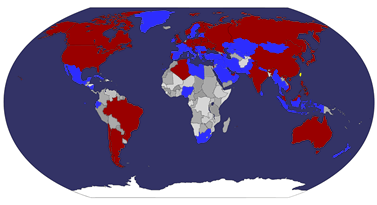Railway Branch Lines Postage Stamps/
Direction des chemins de fer Lignes timbres
Railway branch lines in Taiwan were originally built to serve specific industries, although they later also began to provide regular and economical passenger services for residents along the lines. After a century or so of operation, the branch lines went into decline due to economic transformation, the rise of highway transport, and the rapid development of cities. But in recent years, as people have demonstrated a greater demand for recreational opportunities, some of these branch lines reopened as heritage railways. Furthermore, in order to provide access to high-speed-rail stations, new branch lines have also been built.
In order to raise understanding about these railway branch lines, Chunghwa Post is issuing a set of five stamps, printed in the format of a vertical se-tenant strip, on November 12, 2011. The designs follow:
1. Shalun Branch Line (NT$5): This 6.52-kilometer branch line in Tainan runs between Zhongzhou Station and Shalun Station, where there is access to Taiwan High Speed Rail’s Tainan station. Aimed at better meeting the Tainan metropolitan area’s transportation needs by linking the high-speed rail line with traditional rail and the planned mass transit system, the building of the branch line required reconstructing the Zhongzhou Station and building two new elevated stations: the aforementioned Shalun Station and the Chang Jung Christian University Station. The line was completed and opened to traffic on January 2, 2011.
2. Jiji Branch Line (NT$5): This 29.7-kilometer branch line runs between Changhua’s Ershui Station and Nantou’s Checheng Station. Originally built for transporting building materials, the line would later carry regular passenger trains and freight trains. Today, it has been transformed into a tourist line. This branch line offers great scenic vistas. Its “green tunnels” is a tourist-worthy attraction. In April of 2010, the section between Longquan and Checheng was closed for tunnel renovations. On July 9, 2011, the project was completed, and the line was once again fully opened.
3. The Neiwan Branch Line (NT$12): This 29.9-kilometer branch line runs between Hsinchu Station and Neiwan Station. Originally built for the agriculture, logging, and mining industries, the line gradually shifted its focus to passenger service. There’s a plethora of natural beauty, cultural assets, and ecological resources along the way. In accordance with a plan to improve this line as well as the Liujia Branch Line, beginning in March of 2007, a section on the line between the Hsinchu and Zhudong stations was closed. It is scheduled to reopen on November 12, 2011.
4. Liujia Branch Line (NT$12): This 11.28-kilometer branch line runs between Hsinchu Station and Liujia Station. To meet the transportation needs in the area between Hsinchu and THSR’s Hsinchu Station in Liujia, the Taiwan Railways Administration has undertaken a project to connect its TRA system to the THSR. This project involves elevating the section between the Bei Hsinchu Station and Zhuzhong Station, a section to connect the Zhuzhong Station to the Liujia Station, and building five new stations. The line is expected to open on November 12, 2011.
5. Pingxi Branch Line (NT$15): This 12.9-kilometer branch line runs between Sandiaoling and Jingtong of New Taipei City. Originally a railroad built exclusively to ship coal, it was later for passenger and freight trains. The line boasts views of enchanting rural landscapes. The quaint old streets of the towns along the line, the old train stations, and folk customs such as the releasing of sky lanterns in Pingxi have all contributed to make this branch line a popular and unique tourist line.
Comic image picture of Hsinchu area in Liujia Sta., By Lai, Youxian, who a comic author from Hsinchu, Taiwan.















.png)




















 taiwan
taiwan  cover or postcard
cover or postcard  FDC
FDC 





























































































